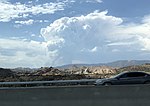Neenach, California
Antelope ValleyButterfield Overland Mail in CaliforniaEl Camino ViejoPopulated places in the Mojave DesertStagecoach stops in the United States ... and 3 more
Unincorporated communities in CaliforniaUnincorporated communities in Los Angeles County, CaliforniaUse mdy dates from July 2023

Neenach ( NEE-nak) is an agricultural settlement in northwestern Los Angeles County, California, United States, with a population of about 800. It is facing a massive change with the proposed construction of a 23,000-home planned community to its north called Centennial.
Excerpt from the Wikipedia article Neenach, California (License: CC BY-SA 3.0, Authors, Images).Neenach, California
West Avenue C 15,
Geographical coordinates (GPS) Address Nearby Places Show on map
Geographical coordinates (GPS)
| Latitude | Longitude |
|---|---|
| N 34.775833333333 ° | E -118.56833333333 ° |
Address
West Avenue C 15
West Avenue C 15
California, United States
Open on Google Maps




